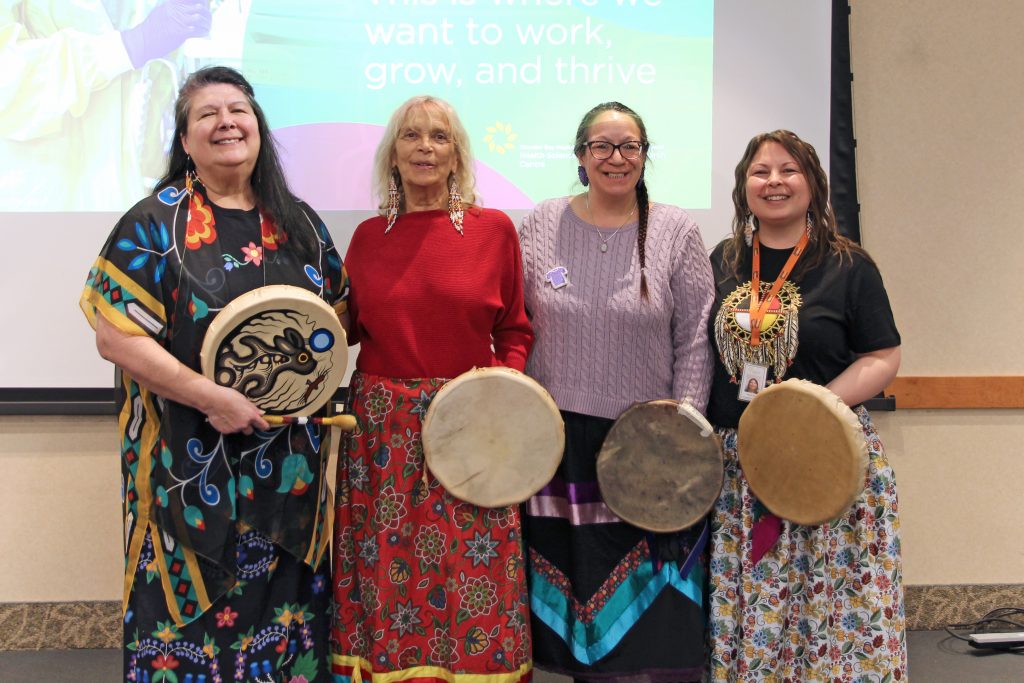The Healing Power of Drumming
by Gina Fata
 (L-R) Charlene Bourdeau Waboose, Celina Reitberger, Natalie Hache and Annette Klement (Cultural Safety Educator, TBRHSC) of the All My Relations Drum Group.
(L-R) Charlene Bourdeau Waboose, Celina Reitberger, Natalie Hache and Annette Klement (Cultural Safety Educator, TBRHSC) of the All My Relations Drum Group.(Originally published in the July 2024 edition of The Walleye Magazine)
Summer in Thunder Bay is a great time to be outdoors and enjoy the beauty of Northwestern Ontario with our friends and family. Events are happening throughout the summer that cater to everyone from food enthusiasts to music lovers. You might encounter people drumming at these events. The strong, captivating beat of the drum fills the air with positivity and attracts people, sometimes even giving you goosebumps.
Drumming is a sacred practice in Indigenous culture, tradition, and teachings. According to teachings passed down through Drum Carriers, each drum, like humans, has its own voice and spirit. While songs and teachings about the drum vary across Turtle Island, the significance of the drum remains constant. It serves as a means to connect with our Ancestors and acts as a bridge between the Spirit and Earth worlds. Drumming provides a tool for us to send out our prayers.
The drum symbolizes the heartbeat of Mother Earth and serves as a reminder of our responsibility to preserve and care for Mother Earth. Our attraction to the beat of the drum stems from the fact that the first sound we hear in our mother’s womb is her heartbeat.
Drums are created by stretching an animal hide over a wooden frame that can be held by an individual or be large enough to accommodate a six-member host drum. The shape of the drum holds symbolism; in many Indigenous teachings, the circle represents life, the cycle of the seasons, as well as the sun and moon. The circle is often used to represent balance, equality, and connection in drum teachings.
In many communities, the drum is treated as if it were alive. It is seen as a sacred item and to give a drum its voice, it may need to be “birthed” in a sacred ceremony. If practicing this ceremony, a drum should not be used until this has takes place. During this ceremony, the drum is connected to the drummer’s voice.
Drumming holds a significant presence in a variety of situations. Drums are used to commence important work, to start a safe journey for those travelling and hunting, and even to give strength during a hard time. Some songs are meant to welcome the public, while others are more private and only sung by the owner.
The rhythm that comes from the drum aids in promoting healing and aligning our physical, spiritual, mental, and emotional well-being. The beautiful sound of the drum can increase energy levels and help release tension. Individuals who partake in drumming, whether that be by listening, dancing, or singing along to the songs, can find a sense of emotional relief and center themselves.
One thing to remember, while enjoying drumming, it is important to understand and respect the practice. According to teachings, individuals can only touch or use another person’s drum if they are given permission to do so.
Thunder Bay Regional Health Sciences Centre (TBRHSC) is committed to creating a more culturally safe and compassionate health care environment — to ensure equity for all throughout our Hospital. Many patients, their families, and caregivers who access care at the TBRHSC practice traditional ceremonies, including drumming, as a part of the healing process. Drumming is available to patients, families and staff at TBRHSC. “Drumming is very healing and we are very happy to be able to provide this traditional medicine to our patients,” said Annette Klement, Cultural Safety Educator at TBRHSC.
Patients can request drumming as apart of their healing journey through the Indigenous Care Coordinators, Spiritual Care or the Cultural Safety Educator.